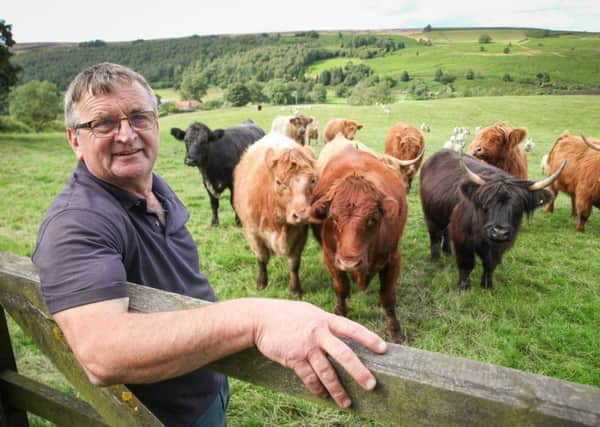Solving the horns of a dilemma


Graeme Thompson’s North Country Cheviots give Castleton a subtle livestock landscape change to the likes of Goathland and other villages with the breed brought in due to the Swaledales’ penchant for scratching and dinting cars, perhaps exacting some form of retribution for the carnage that is all too evident up on the Moors away from villages when people drive too fast and without care.
“After foot and mouth disease restrictions were lifted the Court Leet approached me to run ewes on the edge of the village and then Derek Champion who owned the local garage asked ‘can thou get some sheep without any horns lad?’ as Swaledales and Scotch Blackface ewes used to come down, see nice shiny cars and head-butt them, so I went up to Longtown livestock market and bought a few gimmers in 2002.”
Advertisement
Hide AdAdvertisement
Hide AdGraeme farms the land that his father Bill used to farm before him at Howe Wath Farm in Castleton, but lives in Commondale. He was born in Westerdale, works at Botton in Danby Dale and next Wednesday he will once again be at Danby Show where he is vice chairman, livestock secretary, shows his Highland cattle and this year will be helping Botton residents show dairy calves.
“I always wanted to farm, but I’ve also always known that I’ve had to have another job. I have 70 acres at Howe Wath and rent more. When dad retired 27 years ago my landlord Christopher Robson helped me out to get me started. The land, which is all grass and rough grazing is mainly to the north and east of the village going towards the Eskdale pub. I’d had sheep but right from being a lad and holidaying in Scotland I’d liked Highland cattle and just before foot and mouth year I bought a couple from the breed sale at Oban. I go there every year and it is where I’ve bought most of my cows.”
The livestock enterprise sees Graeme with around 130 North County Cheviot breeding ewes and a dozen Highland cows with 40-head overall. Graeme trades his sheep at the annual Wombleton sheep sale and has recently started crossing his Highlands with a Beef Shorthorn bull to get to beef a little quicker.
“I sell my Cheviots as stores and they do just as well there as anywhere. I prefer my Highlands over the Beef Shorthorn X so I’m not moving away from pedigrees but I thought I’d just try something that might provide beef at two and a half years rather than three and a half.
Advertisement
Hide AdAdvertisement
Hide Ad“The calves from the crossing are now year olds and are running with the two-year-old Highlands. They’re already about the same size. I have a young Highland bull that will come into service next year. He’s not related to many of the cows in the herd so I’ll look at putting him to the best of them.
“Highlands are popular in the North York Moors as the land is similar to Scotland. A lot of the Highlands around here on other farms have come from my herd. We show at Danby and there’s a good following for the breed with sometimes as many as six breeders exhibiting.
“We also supply one or two bullocks for the Fox & Hounds at Ainthorpe. The beef has done well on their specials board and the owners Nigel and Adrian who have a bit of land themselves market it as their own as we run some stock there.”
Graeme drove a milk wagon for 23 years, collecting from dairy farms throughout the Moors. He then worked as a rep for farm supplies company BATA at Ruswarp before taking up his role today running the dairy herd with Colin Dowson at Botton Farm.
Advertisement
Hide AdAdvertisement
Hide Ad“When I started on tankers the Esk valley from Guisborough to Robin Hood’s Bay had 253 dairy farms, today there are less than 50. Goathland had 25 and now there’s just one left. The first tanker I drove held 9,000 litres but when I packed up seven years ago I was driving a 20,000-litre wagon. There was always talk that little farms weren’t viable, especially when it came to milk collection, but they were.
“I enjoyed my time with BATA as I was covering the same area I’d worked as a tanker driver and knew many of the people but when this job came up I thought I’d give it a go.
“Colin and I have around 50 Dairy Shorthorn cows and the milk produced stays in the village. What doesn’t get used as fresh milk in the households goes into the creamery where cheese is produced. Everything here is resident-oriented for people with learning difficulties and quite a few enjoy coming up here and milking with us.
“It is rewarding work, seeing how much they get out of it. It also gives me the opportunity to farm, along with my Cheviots and Highlands, and enjoy without quite the stress if Botton Farm was my own.”
Danby Show takes place on August 16.